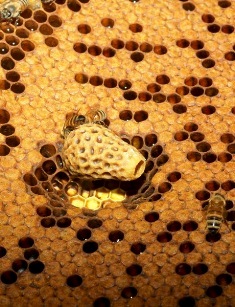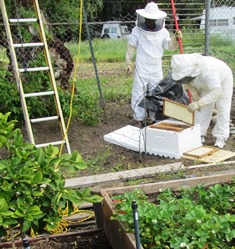20 Interesting Facts about Honeybees
If your fruit trees, berries, and flowers are flourishing, you can be assured that bees have been busy in your garden. If you are a gardener who lives near a beekeeper, consider yourself really fortunate. Eighty percent of pollination is attributed to bees. Without these industrious little insects, Earth’s plant diversity would be in jeopardy. Here are some other interesting facts about honeybees (apis mellifera).
WORKER HONEYBEES
1. The worker honeybees are sterile females. The workers keep the hive clean, serve as nursemaids to the babies, forage for food, scout for new locations, stand guard at the hive entrance, and care for the queen.
2. The lifespan of a worker bee is 6 to 8 weeks; the queen’s lifespan can stretch to 3 years.
3. In her short lifetime, an average worker bee will produce about 1 1/2 teaspoons of honey.
4. A honeybee will travel about six miles from its hive to forage on nectar- or pollen-rich plants.
5. Honeybees never sleep.
6. During one collection flight, a honeybee will visit between 50 and 100 flowers.
THE QUEEN
7. A honeybee queen is made or created (as opposed to being born). Worker bees secrete royal jelly through the glands in their heads (hypopharynx and mandibular) to feed the larvae. Rich in vitamins and nutrients, the royal jelly may also contain a single protein known as royalactin and scientists believe this ingredient ensures the larva becomes a queen.
8. Newly emerged queens will fight to the death, leaving only one to rule the hive. The honeybee queen lays around 2,000 eggs. These become fully developed in 21 days.
9. The queen doesn’t leave the hive. Her job is to mate with the drones, produce eggs, and serve as matriarch of the colony.
THE DRONES
10. Drones are bigger than the worker bees but smaller than the queen and have rear-ends that are more blunted than round.
11. The drone’s sole purpose is to mate with the queen, which he does in the air. Drones die during mating.
12. Drones do not have stingers unlike the worker bees who have stingers with bee venom.
13. Drones are kicked out of the colony in the autumn when mating season in over because the honey reserves are needed to support the colony’s queen and workers through the winter. The drones are expendable since they don’t forage for food, make honeycomb or honey, care for the babies, clean the hive, or otherwise contribute to the colony.
THE COLONY
14. Honeybees communicate with each other through chemical signals. When there is a predator present, the worker bees release a pherome that communicates to her hive mates the need to attack.
15. The primary swarm (with the old queen) happens in spring and is a colony in transition. Swarming is the method by which the bees leave the hive en masse to establish a new colony. Swarming usually occurs during a two-week period in spring on warm days.
16. A swarm can include 10,000 bees but they are not in attack mode; they are preparing to move to a new home with their queen and are carrying the honey they need for the trip in their stomachs.
17. Honeybee colonies have been around for millions of years. There are fossils of honeybees in European deposits dating back 23 to 56 million years ago.
HONEY
18. Honeybees are the only insects that produce a product that humans eat. Honey is highly nutritious and has many health benefits.
19. Honey never goes bad; honey was found in King Tut’s tomb.
20. It takes more than 500 honeybees collecting pollen from 2 million flowers to make 1 pound of honey.
Swarming Season Has Arrived!
What’s not to love about spring? It’s only the middle of April and already we’ve seen several honeybee swarms. Swarming is how the bees reproduce their colonies and most often occurs during the warm days of early spring.
My neighbor, whom I’ve often called a world-class beekeeper (his father kept honeybees in Lebanon and taught him well) permitted me to keep his bee swarm that alighted in my apricot tree. He also generously donated a super (hive box) with some frames that already had wax, honey, and capped brood–all from his own apiary.
The newly housed honeybee workers delight in foraging on the various types of lavender (Spanish, English, and French perfume) that I’ve planted around the farmette. The colony will build up the wax and make honey while the nursemaid bees will care for the brood.
My husband, the architect-turned-farmer/beekeeper, has constructed a unique bee house for the hives. It will keep the bee boxes dry during winter rains and out of reach of marauding animals (skunks and raccoons). Resting on a platform that Carlos built on top of a newly installed brick floor, the hives are not within easy reach of the ever present ant population.
Alas, the bees weren’t about to wait until Carlos finished building their house. The swarm happened when the bees were ready to take flight (some 60 percent of the workers with their old queen) flew into our apricot tree.
If you see a swarm, call your local beekeeping association (or any store that carries local honey) for the name of a beekeeper. Avoid the temptation of spraying water or anything else on the swarm. Permit the beekeeper to safely remove the swarm.
For a beekeeper, rescuing a swarm is a truly exhilarating experience. Often a swarm consists of thousands to tens of thousands of honeybees. Beekeepers routinely rescue swarms from where bees have temporarily clustered while the bee scouts seek a permanent home. The beekeeper can shake them into a prepared hive box, leaving the box at the hive cluster site until all the bees are inside. At that point, the beekeeper takes the new hive to his apiary.
The beleaguered honeybees (whose populations have been decimated by the Varroa mite, weakened immune systems, and Colony Collapse Disorder) need help to survive and increase their populations. We need them, too! Without their pollination of fruit, nut, and other crops, our own food sources diminish.
Saving the honeybees is a good practice whenever possible because doing so ensures abundance and diversity in the plants we eat. Whenever I see a cluster of bees in a tree I feel joyful and celebratory. Is it any wonder that swarming season is my favorite time of the year?
 Facebook
Facebook Goodreads
Goodreads LinkedIn
LinkedIn Meera Lester
Meera Lester Twitter
Twitter









